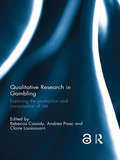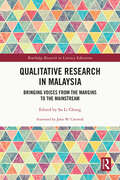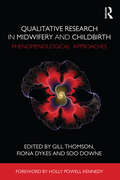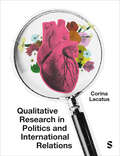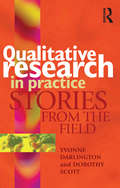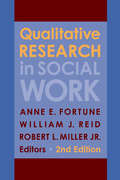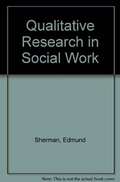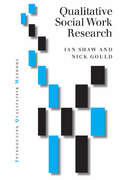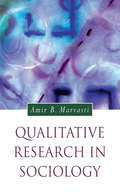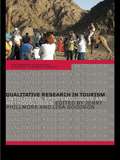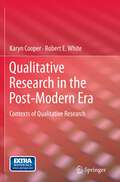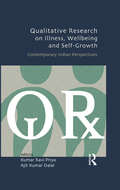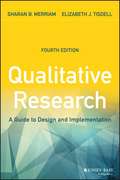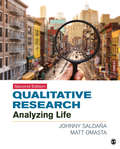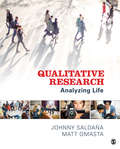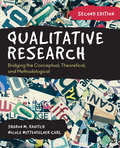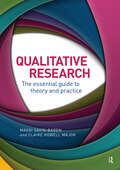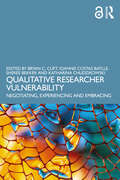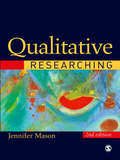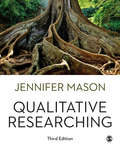- Table View
- List View
Qualitative Research in Gambling: Exploring the production and consumption of risk
by Rebecca Cassidy Andrea Pisac Claire LoussouarnThe Open Access version of this book, available at http://www.tandfebooks.com, has been made available under a Creative Commons Attribution-Non Commercial-No Derivatives 3.0 license. Gambling is both a multi-billion-dollar international industry and a ubiquitous social and cultural phenomenon. It is also undergoing significant change, with new products and technologies, regulatory models, changing public attitudes and the sheer scale of the gambling enterprise necessitating innovative and mixed methodologies that are flexible, responsive and ‘agile’. This book seeks to demonstrate that researchers should look beyond the existing disciplinary territory and the dominant paradigm of ‘problem gambling’ in order to follow those changes across territorial, political, technical, regulatory and conceptual boundaries. The book draws on cutting-edge qualitative work in disciplines including geography, organisational studies, sociology, East Asian studies and anthropology to explore the production and consumption of risk, risky places, risk technologies, the gambling industry and connections between gambling and other kinds of speculation such as financial derivatives. In doing so it addresses some of the most important issues in contemporary social science, including: the challenges of studying deterritorialised social phenomena; globalising technologies and local markets; regulation as it operates across local, regional and international scales; and the rise of games, virtual worlds and social media.
Qualitative Research in Malaysia: Bringing Voices from the Margins to the Mainstream (Routledge Research in Literacy Education)
by Su Li ChongThis edited volume is a systematic collection of research initiatives in the qualitative research paradigm. It showcases how researchers in Malaysia, who are often expected to acquiesce to mainstream ways of designing, conducting and disseminating research, rise above methodological hegemony to carve out a different but meaningful path in order to represent the voice of the voiceless.In this book, accounts of paradigmatic shifts, applications of philosophical rigour and attention to values-laden inquiry demonstrate how qualitative research can be successfully conducted and reported, revealing insights which profoundly re-shape research design and address ethical sensitivities in social research. The conclusions drawn from the chapters form the rallying cry of qualitative researchers who acknowledge that it is their responsibility to enlighten those who are gatekeepers to the national research agenda, about the strength and legitimacy of the qualitative research paradigm. From a global standpoint, this book functions as a foil to show how in a context not systematically underpinned by critical dialogues of Western philosophy nor the ideology of research paradigms, significant considerations positioned within Eastern concepts of knowledge production can still thrive. The integration of both Eastern and Western perspectives at the crossroads of Asian-based qualitative research offers important lessons that are useful for supervisory, teaching and learning purposes.This volume will be relevant to qualitative research methodology educators and researchers from across the Sciences and Humanities as well as practitioners in any industry that involves human thought and behaviour.
Qualitative Research in Midwifery and Childbirth: Phenomenological Approaches
by Soo Downe Gill Thomson Fiona DykesQualitative research, particularly phenomenology, is increasingly popular as a method for midwifery and health-related research. These approaches enable rich and detailed explanations to be uncovered and bring experience to life. Important recommendations and practice- based implications may then be raised and debated for future use. This book brings together a range of phenomenological methods and insights into one accessible text. Illustrated with plenty of examples of successful phenomenological research, Qualitative Research in Midwifery and Childbirth keeps the focus applied to midwifery and childbirth and makes clear the links to practice throughout. The book introduces three key phenomenological approaches – descriptive, interpretive and the life world – and includes a comparative chapter which discusses the differences between these varied perspectives and methods. Each chapter focuses on how these approaches are used within midwifery research. The remaining chapters present a number of different research projects. These demonstrate how different phenomenological approaches have been used to explore and uncover experiences of childbirth and maternity as well as offering important insights into how women experience different facets of the birth experience during the antenatal, intra-partum and postnatal period. Designed for researchers and students undertaking research projects on midwifery and childbirth, this text includes contributions from a range of international and highly regarded phenomenological authors and researchers.
Qualitative Research in Politics and International Relations: A practical and pluralist guide
by Corina LacatusThis groundbreaking textbook is the essential introduction to qualitative research for politics and international relations. Presented in a refreshingly accessible manner, this text applies a practical approach to help you learn by doing and will equip you with the tools to get researching. Embrace a pedagogical approach that seamlessly integrates theoretical insights with hands-on guidance, empowering you to navigate the complexities of qualitative research with confidence and clarity. Key Benefits Include: · Practical Approach: bid farewell to abstract learning with practical tools and exercises that instil intuition and proficiency. Step-by-step support for students grappling with the logistical intricacies of research design, data collection, and analysis. · Close Links to the Disciplines: immerse yourself in the latest seminal research and learn how to select robust qualitative designs for your research questions. · Demystify Theory and Methodology: this text addresses the perennial challenge of aligning theory with methodology, providing a cohesive framework for qualitative research. · Expert Guidance: for educators seeking to incorporate this invaluable resource into their curriculum, a complementary online teaching guidebook offers guidance and suggestions on how to truly engage with the material and enrich the learning experience for your students. An essential companion for undergraduate students navigating qualitative methods modules to postgraduate students and researchers shaping their research projects. Corina Lacatus is a Senior Lecturer in Global Governance at the School of Politics and International Relations, Queen Mary University of London.
Qualitative Research in Politics and International Relations: A practical and pluralist guide
by Corina LacatusThis groundbreaking textbook is the essential introduction to qualitative research for politics and international relations. Presented in a refreshingly accessible manner, this text applies a practical approach to help you learn by doing and will equip you with the tools to get researching. Embrace a pedagogical approach that seamlessly integrates theoretical insights with hands-on guidance, empowering you to navigate the complexities of qualitative research with confidence and clarity. Key Benefits Include: · Practical Approach: bid farewell to abstract learning with practical tools and exercises that instil intuition and proficiency. Step-by-step support for students grappling with the logistical intricacies of research design, data collection, and analysis. · Close Links to the Disciplines: immerse yourself in the latest seminal research and learn how to select robust qualitative designs for your research questions. · Demystify Theory and Methodology: this text addresses the perennial challenge of aligning theory with methodology, providing a cohesive framework for qualitative research. · Expert Guidance: for educators seeking to incorporate this invaluable resource into their curriculum, a complementary online teaching guidebook offers guidance and suggestions on how to truly engage with the material and enrich the learning experience for your students. An essential companion for undergraduate students navigating qualitative methods modules to postgraduate students and researchers shaping their research projects. Corina Lacatus is a Senior Lecturer in Global Governance at the School of Politics and International Relations, Queen Mary University of London.
Qualitative Research in Practice: Stories from the field
by Dorothy Scott Yvonne Darlington'Qualitative Research in Practice brings alive wonderfully the business of carrying out qualitative research in the field of welfare and human services. The authors take the reader through the main stages of the research endeavour, cleverly using their own interviews with eminent investigators to illustrate with great immediacy the actual mechanics of the process as described by recognised experts.'Professor David Howe, School of Social Work and Psychosocial Studies, University of East Anglia, Norwich, UK.'.very useful and invaluable for social work students and social workers.'Joyce L. C. Ma, R.S.W. Ph.D., Professor, Department of Social Work, The Chinese University of Hong KongQualitative Research in Practice bridges the gap between theory and practice for researchers in the human services. The authors explore qualitative research through actual research projects that illustrate key stages in the research process. The researchers' 'stories from the field' reveal the human face of research undertaken in often difficult contexts: with homeless people, with disabled people, in nursing homes, with victims of domestic violence, and with adopted children. We see how these leading researchers from different countries deal with the many obstacles they face in their research projects, and how they develop innovative solutions. Qualitative Research in Practice is a valuable resource for students and practitioners doing research in social work, welfare, community health, counselling and related fields.
Qualitative Research in Social Work
by Jr. William J. Reid Robert Miller Anne FortuneIn this volume, progressive experts survey recent trends in qualitative study, which relies on small sample groups and interview data to better represent the context and complexity of social work practice. Chapters address different approaches to qualitative inquiry, applications to essential areas of research and practice, integration of qualitative and quantitative methods, and epistemological issues. This second edition brings even greater depth and relevance to social work qualitative research, including new material that tackles traditional research concerns, such as data quality, ethics, and epistemological stances, and updated techniques in data collection and analysis. To increase the usefulness for students and researchers, the editors have reorganized the text to present basic principles first and then their applications, and they have increased their focus on ethics, values, and theory. New and revised illustrative studies highlight more than ever the connection between effective research and improved social functioning among individuals and groups. The collection continues to feature scholars and practitioners who have shaped the social work research practice canon for more than twenty years, while also adding the innovative work of up-and-coming talent.
Qualitative Research in Social Work
by William J. Reid Edmund ShermanIn this volume, progressive experts survey recent trends in qualitative study, which relies on small sample groups and interview data to better represent the context and complexity of social work practice. Chapters address different approaches to qualitative inquiry, applications to essential areas of research and practice, integration of qualitative and quantitative methods, and epistemological issues. <p><p> This second edition brings even greater depth and relevance to social work qualitative research, including new material that tackles traditional research concerns, such as data quality, ethics, and epistemological stances, and updated techniques in data collection and analysis. To increase the usefulness for students and researchers, the editors have reorganized the text to present basic principles first and then their applications, and they have increased their focus on ethics, values, and theory. New and revised illustrative studies highlight more than ever the connection between effective research and improved social functioning among individuals and groups. The collection continues to feature scholars and practitioners who have shaped the social work research practice canon for more than twenty years, while also adding the innovative work of up-and-coming talent.
Qualitative Research in Social Work (Introducing Qualitative Methods #113)
by Dr Nick Gould Professor Ian Shaw`A really fine book... an impressive work that adds much to the development of the use of qualitative methodology in social work research' - William J Reid, University at Albany 'The back cover of the book proclaims that "Qualitative Research in Social Work will be essential reading for all students, practitioners and researchers undertaking social work research." That just about sums it up for me' - British Journal of Social Work `This book is a significant milestone in the development of social work research. It is characterized by an unparalleled command of the field of qualitative research in social work, and by a commitment to an understanding of the demands and potential of day-to-day social work practice' - Mike Fisher, Director of Research, National Institute for Social Research `Qualitative Research in Social Work edited by Ian Shaw and Nick Gould, provides a state-of-the-art exposition and analysis of qualitative inquiry in relation to social work.... The book has an unusual degree of coherence for one with several authors. The five chapters by the editors (parts one and three) do an exceptional job of providing the necessary background information and setting the context for the six application chapters and of highlighting and discussing the issues raised in those chapters. The editors are respected scholars well-versed in the theory and practice of qualitative research. Similarly, the contributing authors represent both considerable experience in this field and a diversity of interests. This combination makes Qualitative Research in Social Work an excellent text for students, practitioners, and researchers alike. It is a benchmark for social work progress in this area and points the way for the continued development of qualitative inquiry' - Professor Stanley L Witkin, Department of Social Work, University of Vermont There is a clear need for a book which treats qualitative research as a substantive theme within social work, setting epistemological and methodological issues in a context whereby the agenda is set by, and is relevant to, social work. Qualitative Research in Social Work is just such a book and will be immensely useful for students, practitioners and researchers interested in and undertaking social work research. In the introductory chapters the co-authors set qualitative research within a context of social work developments and problems. The central section provides additional topicality and directness through specially commissioned chapters from leading figures in this field each covering key qualitative methods and relating them to social work settings, and the final section which reviews qualitative research in social work, and aims to exemplify ways in which social work thought and practice can be advanced through research.
Qualitative Research in Sociology (Introducing Qualitative Methods)
by Amir B. Marvasti'The book is an extremely valuable resource for students and new researchers who embark on qualitative research in sociology and the social sciences. It will be a valuable source for those who teach qualitative research methods in not only the social sciences but also in other disciplines, including health science. I wholeheartedly recommend this book' - Australian Journal of Primary Health Qualitative Research in Sociology offers a hands-on guide to doing qualitative research in sociology. It provides an introductory survey of the methodological and theoretical dimensions of qualitative research as practised by those interested in the study of social life. Through a detailed yet concise explanation, the reader is shown how these methods work and how their outcomes may be interpreted. Practically focused throughout, the book also offers constructive advice for students analysing and writing their research projects. Key features of the book include: · An innovative framework - combining different methodologies and approaches. · A variety of `real-life' examples and case studies - enriches the book for the reader · A set of practical exercises in each chapter - pedagogical and student-focussed throughout. · International in focus - offers a wide-ranging set of approaches and debates · A broad coverage - includes discussions of ethnography, visual analysis, ethical issues, discourse and conversation analysis and report-writing The book has a flowing narrative and student-friendly structure which makes it accessible to and popular with students. It will be an invaluable resource for students and researchers, helping them to undertake effective qualitative research in both sociology and courses in social research across the social sciences.
Qualitative Research in Tourism: Ontologies, Epistemologies and Methodologies (Contemporary Geographies of Leisure, Tourism and Mobility)
by Lisa Goodson Jenny PhillimoreThe first to focus solely upon qualitative research in tourism, this book combines discussions of the philosophies underpinning qualitative research, with reflexive chapters that demonstrate how these techniques can be used. Incorporating a range of case studies written by leading international scholars, this book makes clear the ways in which these pieces of research have been informed by the authors' epistemological, ontological and methodological standpoint. Based on a range of empirical tourism studies set in the context of theoretical discussion, it demonstrates the benefits of using a range of qualitative approaches to research tourism, exploring the ways in which a number of techniques, including participants observation, memory work, biographical diaries, focus groups and visual exercises, have been adopted by researchers from a range of disciplinary backgrounds to undertake empirical research in tourism. An indispensable text for final year undergraduates, Masters and PhD students embarking on research in the field, it also will be a valuable title for academics with an interest in either tourism research or qualitative methodology. Linking theory with research practice, it offers a holistic account of qualitative research in tourism.
Qualitative Research in the Post-Modern Era
by Robert E. White Karyn CooperQualitative Research is changing as a result of postmodern influences which have changed the way research is interpreted and understood. This has prompted questions which have been knocking at the door of qualitative research for some time now: Who is the researcher in this research account? How does the researcher relate to his/her research? How can the researcher who reads qualitative research relate to and understand the nuances and complexities in qualitative research? How can this volume help us to, not only describe, effect and manage change, but help us to understand, imagine and affect policies, practices and procedures related to research? What can we learn from researchers at the top of their stride who have struggled in order to develop qualitative research? The book includes illustrative interviews with world famous scholars. William Pinar, Norman Denzin, Henry Giroux, Zygmunt Bauman and Maxine Greene invite the student to engage reflectively and to figure out the rudiments and connections of research methodology and methods for theses. The developed so called "The Five Contexts" serves as a theoretical framework for conducting, understanding and interpreting qualitative research in a variety of disciplines in this post-modern era .
Qualitative Research on Illness, Wellbeing and Self-Growth: Contemporary Indian Perspectives
by Kumar Ravi Priya Ajit Kumar DalalThis book examines the theoretical, methodological and practical dimensions of Qualitative Research in the study of illness, wellbeing and self-growth in the Indian context. Using wide-ranging narratives, interviews, group discussions, and cultural analyses, it offers a social and psychological understanding of health and therapy.
Qualitative Research: A Guide To Design And Implementation
by Sharan B. Merriam Elizabeth J. TisdellPraise for the Third Edition of Qualitative Research: "Sharan B. Merriam synthesizes twenty years of developments in qualitative research with clarity and acumen." ?Michael Quinn Patton, author, Qualitative Research and Evaluation Methods "Here is a qualitative research methods book that reinforces the connection between professional experience and qualitative inquiry." ?Robert Stake, author, The Art of Case Study Research and Multiple Case Study Analysis "In this new edition, Sharan Merriam once again presents the world of qualitative research in language engaging and accessible?for new and experienced readers alike. If you can have only one book about qualitative research, this is it!" ?Patricia M. Reeves, associate professor, School of Social Work, University of Georgia "Mystified by qualitative research? You couldn't ask for a better guide than Sharan Merriam, who introduces you to the fundamental concepts of this research method, explains its complex forms, and then shows you exactly how to do a high-quality qualitative study." ?M. Carolyn Clark, coeditor, The International Journal of Qualitative Studies in Education
Qualitative Research: Analyzing Life
by Johnny Saldana Matt OmastaQualitative Research: Analyzing Life, Second Edition presents a fresh approach to teaching and learning qualitative methods for social inquiry—one that focuses on analysis from the very beginning of the text. By exploring qualitative research through a unique analytic lens, then cumulatively elaborating on methods in each successive chapter, this innovative work cultivates a skill set and literacy base that prepares readers to work strategically with empirical materials in their own fieldwork. Johnny Saldaña and Matt Omasta combine clear, accessible writing and analytic insight to show that analysis, in its broadest sense, is a process undertaken throughout the entire research experience. The Second Edition provides a number of updates including more on digital materials and methods, including sentiment analysis of social media data, and ethics in social media research.
Qualitative Research: Analyzing Life
by Johnny Saldana Matt OmastaQualitative Research: Analyzing Life, Second Edition presents a fresh approach to teaching and learning qualitative methods for social inquiry—one that focuses on analysis from the very beginning of the text. By exploring qualitative research through a unique analytic lens, then cumulatively elaborating on methods in each successive chapter, this innovative work cultivates a skill set and literacy base that prepares readers to work strategically with empirical materials in their own fieldwork. Johnny Saldaña and Matt Omasta combine clear, accessible writing and analytic insight to show that analysis, in its broadest sense, is a process undertaken throughout the entire research experience. The Second Edition provides a number of updates including more on digital materials and methods, including sentiment analysis of social media data, and ethics in social media research.
Qualitative Research: Analyzing Life
by Mr Johnny Saldana Matt OmastaQualitative Research: Analyzing Life presents a fresh approach to teaching and learning qualitative methods for social inquiry—one that focuses on analysis from the very beginning of the text. By exploring qualitative research through a unique analytic lens, then cumulatively elaborating on methods in each successive chapter, this innovative work cultivates a skill set and literacy base that prepares readers to work strategically with empirical materials in their own fieldwork. Renowned authors Johnny Saldaña and Matt Omasta combine clear, accessible writing and analytic insight to show that analysis, in its broadest sense, is a process undertaken throughout the entire research experience.
Qualitative Research: Analyzing Life (Understanding Qualitative Research Ser. #3)
by Mr Johnny Saldana Matt OmastaQualitative Research: Analyzing Life presents a fresh approach to teaching and learning qualitative methods for social inquiry—one that focuses on analysis from the very beginning of the text. By exploring qualitative research through a unique analytic lens, then cumulatively elaborating on methods in each successive chapter, this innovative work cultivates a skill set and literacy base that prepares readers to work strategically with empirical materials in their own fieldwork. Renowned authors Johnny Saldaña and Matt Omasta combine clear, accessible writing and analytic insight to show that analysis, in its broadest sense, is a process undertaken throughout the entire research experience.
Qualitative Research: Bridging the Conceptual, Theoretical, and Methodological
by Dr. Sharon M. Ravitch Dr. Nicole C. CarlThe second edition of Qualitative Research focuses on cultivating and bridging theoretical, methodological, and conceptual aspects to provide insight into their interactions in qualitative research. This comprehensive text helps students understand the central concepts, topics, and skills necessary to engage in rigorous, valid, and respectful qualitative research. Authors Sharon M. Ravitch and Nicole Mittenfelner Carl have written this text with student researchers in mind, balancing communicating the foundations and processes of qualitative research with clarity and simplicity while also capturing its complexity and layers. Whether students are new to qualitative research or not, this book will help students develop and deepen their understanding of an approach to research that seeks, designs for, and engages criticality in research. The new edition of this text includes a more prominently-placed and expanded discussion of research ethics, more information on reflexivity in data collection, more in-depth coverage coding and other types of qualitative data analysis, and more thorough resource sections including connections to the extensive appendices so students can further their qualitative research journey.
Qualitative Research: Bridging the Conceptual, Theoretical, and Methodological
by Dr. Sharon M. Ravitch Dr. Nicole C. CarlThe second edition of Qualitative Research focuses on cultivating and bridging theoretical, methodological, and conceptual aspects to provide insight into their interactions in qualitative research. This comprehensive text helps students understand the central concepts, topics, and skills necessary to engage in rigorous, valid, and respectful qualitative research. Authors Sharon M. Ravitch and Nicole Mittenfelner Carl have written this text with student researchers in mind, balancing communicating the foundations and processes of qualitative research with clarity and simplicity while also capturing its complexity and layers. Whether students are new to qualitative research or not, this book will help students develop and deepen their understanding of an approach to research that seeks, designs for, and engages criticality in research. The new edition of this text includes a more prominently-placed and expanded discussion of research ethics, more information on reflexivity in data collection, more in-depth coverage coding and other types of qualitative data analysis, and more thorough resource sections including connections to the extensive appendices so students can further their qualitative research journey.
Qualitative Research: The Essential Guide to Theory and Practice
by Maggi Savin-Baden Claire Howell MajorQualitative Research: The Essential Guide to Theory and Practice provides a one-stop resource for all those approaching qualitative research for the first time, as well as those revisiting core concepts and issues. It presents a comprehensive overview of this rapidly developing field of inquiry, cleverly combined with practical, hands-on advice on how to conduct a successful qualitative study. Written in an engaging and accessible style, the authors break through difficult terminology to guide readers through the choices they will face during research design, implementation, and beyond. Each chapter is then brought to life by an array of relevant, real-life examples from expert researchers around the globe. Divided into seven sections, this unique text covers: Considering perspectives Acknowledging a position Framing the study Choosing a research approach Collecting data Working with data and findings Writing about the research From the foundations of the subject through to its application in practice, Qualitative Research: The Essential Guide to Theory and Practice is an indispensable companion for qualitative researchers worldwide. VAT will be charged on this product for UK customers only. VAT is charged at standard rate on a part of this product only.
Qualitative Researcher Vulnerability: Negotiating, Experiencing and Embracing
by Bryan C. Clift Sheree Bekker Ioannis Costas Batlle Katharina ChudzikowskiQualitative Researcher Vulnerability provides conceptual, experiential, and practical insights into the vulnerability of the qualitative researcher. Compared to participants’ vulnerability, researcher vulnerability has seen limited attention in the qualitative research process, but yet it is an important consideration. Drawing on an interdisciplinary group of authors—across criminology, education, feminisms, geography, health, kinesiology, nursing, management and organisation, policy, political science, psychology, sociology, and qualitative inquiry writ broad—the book explores the ways in which we might understand and work with researcher vulnerability, most notably in relation to ethics, risk, empathy, emotion, and power. Ultimately, the authors suggest researcher vulnerability is a vital component of our research practices throughout the research process, for emerging as well as experienced researchers. Whilst researcher vulnerability can be something to protect against, it is also something to be aware of, explore, learn from, work with, and at times (and with care and consideration) embrace. This book is suitable for undergraduate, postgraduate students, and emerging and established researchers who are utilising qualitative research. It will be especially useful for researchers examining (potentially) sensitive topics, or for those who wish to develop more responsive, responsible, ethical, or reciprocal approaches to qualitative practices.
Qualitative Researching
by Dr Jennifer MasonThe Second Edition of this bestselling text offers students and first-time researchers invaluable guidance on the practice of qualitative social research. Throughout the author addresses the key issues which need to be identified and resolved in the qualitative research process, and through which researchers develop essential skills in qualitative research. The book highlights the `difficult questions' that researchers should get into the habit of asking themselves in the course of doing qualitative research, and outlines the implications of the different ways of responding to these questions. The new edition of Qualitative Researching has been fully revised and updated with expanded coverage of observation, documents, visual data, CAQDAS, and writing qualitative research. The text bridges the gap between `cookbook' approaches to qualitative research and abstract methodogical approaches. Helping the reader to move comfortably between principle and practice, this text has proved to be an invaluable introduction to qualitative research, and a useful aid to accomplished qualitative research practice across the social sciences.
Qualitative Researching
by Dr Jennifer MasonThe third edition of this best-selling text guides students and researchers through the process of doing qualitative research, clearly explaining how different theoretical approaches inform what you do in practice. The text bridges the gap between ‘cookbook’ and more abstract approaches to qualitative research, by posing ‘difficult questions' that researchers should be asking themselves . The book invites researchers to engage in a creative and critical practice in how they draw insights, interpret a range of types of data and craft knowledge from qualitative research. Fully revised and updated, with three new chapters, this edition: · Covers the full research process, with new material on analysing and interpreting data and research ethics · Engages with exciting new developments in the field through challenging qualitative researchers to be creative with how they research and with what they find. · Examines the potential of qualitatively-led approaches to mixed methods, and their implications for research design, research practice and the production of convincing arguments. A theoretically engaged, grounded approach to qualitative researching, this remains the ideal text to guide students to become thoughtful, creative and effective qualitative researchers.
Qualitative Researching
by Dr Jennifer MasonThe third edition of this best-selling text guides students and researchers through the process of doing qualitative research, clearly explaining how different theoretical approaches inform what you do in practice. The text bridges the gap between ‘cookbook’ and more abstract approaches to qualitative research, by posing ‘difficult questions' that researchers should be asking themselves . The book invites researchers to engage in a creative and critical practice in how they draw insights, interpret a range of types of data and craft knowledge from qualitative research. Fully revised and updated, with three new chapters, this edition: · Covers the full research process, with new material on analysing and interpreting data and research ethics · Engages with exciting new developments in the field through challenging qualitative researchers to be creative with how they research and with what they find. · Examines the potential of qualitatively-led approaches to mixed methods, and their implications for research design, research practice and the production of convincing arguments. A theoretically engaged, grounded approach to qualitative researching, this remains the ideal text to guide students to become thoughtful, creative and effective qualitative researchers.
